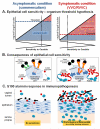Cytokines in the host response to Candida vaginitis: Identifying a role for non-classical immune mediators, S100 alarmins
- PMID: 22182685
- PMCID: PMC3290723
- DOI: 10.1016/j.cyto.2011.11.021
Cytokines in the host response to Candida vaginitis: Identifying a role for non-classical immune mediators, S100 alarmins
Abstract
Vulvovaginal candidiasis (VVC), caused by Candida albicans, affects a significant number of women during their reproductive years. More than two decades of research have been focused on the mechanisms associated with susceptibility or resistance to symptomatic infection. Adaptive immunity by Th1-type CD4(+) T cells and downstream cytokine responses are considered the predominant host defense mechanisms against mucosal Candida infections. However, numerous clinical and animal studies have indicated no or limited protective role of cells and cytokines of the Th1 or Th2 lineage against vaginal infection. The role for Th17 is only now begun to be investigated in-depth for VVC with results already showing significant controversy. On the other hand, a clinical live-challenge study and an established animal model have shown that a symptomatic condition is intimately associated with the vaginal infiltration of polymorphonuclear leukocytes (PMNs) but with no effect on vaginal fungal burden. Subsequent studies identified S100A8 and S100A9 alarmins as key chemotactic mediators of the acute PMN response. These chemotactic danger signals appear to be secreted by vaginal epithelial cells upon interaction and early adherence of Candida. Thus, instead of a putative immunodeficiency against Candida involving classical immune cells and cytokines of the adaptive response, the pathological inflammation in VVC is now considered a consequence of a non-productive innate response initiated by non-classical immune mediators.
Copyright © 2011 Elsevier Ltd. All rights reserved.
Figures


Similar articles
-
The acute neutrophil response mediated by S100 alarmins during vaginal Candida infections is independent of the Th17-pathway.PLoS One. 2012;7(9):e46311. doi: 10.1371/journal.pone.0046311. Epub 2012 Sep 25. PLoS One. 2012. PMID: 23050010 Free PMC article.
-
Epithelial cell-derived S100 calcium-binding proteins as key mediators in the hallmark acute neutrophil response during Candida vaginitis.Infect Immun. 2010 Dec;78(12):5126-37. doi: 10.1128/IAI.00388-10. Epub 2010 Sep 7. Infect Immun. 2010. PMID: 20823201 Free PMC article.
-
Vaginal epithelial cell-derived S100 alarmins induced by Candida albicans via pattern recognition receptor interactions are sufficient but not necessary for the acute neutrophil response during experimental vaginal candidiasis.Infect Immun. 2014 Feb;82(2):783-92. doi: 10.1128/IAI.00861-13. Epub 2013 Dec 9. Infect Immun. 2014. PMID: 24478092 Free PMC article.
-
Immunity to Candida.Oral Dis. 2002;8 Suppl 2:69-75. doi: 10.1034/j.1601-0825.2002.00015.x. Oral Dis. 2002. PMID: 12164664 Review.
-
Novel Mechanism behind the Immunopathogenesis of Vulvovaginal Candidiasis: "Neutrophil Anergy".Infect Immun. 2018 Feb 20;86(3):e00684-17. doi: 10.1128/IAI.00684-17. Print 2018 Mar. Infect Immun. 2018. PMID: 29203543 Free PMC article. Review.
Cited by
-
Signaling through IL-17C/IL-17RE is dispensable for immunity to systemic, oral and cutaneous candidiasis.PLoS One. 2015 Apr 7;10(4):e0122807. doi: 10.1371/journal.pone.0122807. eCollection 2015. PLoS One. 2015. PMID: 25849644 Free PMC article.
-
Recurrent Vulvovaginal Candidiasis: An Immunological Perspective.Microorganisms. 2020 Jan 21;8(2):144. doi: 10.3390/microorganisms8020144. Microorganisms. 2020. PMID: 31972980 Free PMC article. Review.
-
Zinc prevents vaginal candidiasis by inhibiting expression of an inflammatory fungal protein.Sci Transl Med. 2023 Dec 6;15(725):eadi3363. doi: 10.1126/scitranslmed.adi3363. Epub 2023 Dec 6. Sci Transl Med. 2023. PMID: 38055800 Free PMC article.
-
Plasma Levels of IFN-γ, IL-4, IL-6 and IL-17 in HIV-Positive Patients With Oral Candidiasis.Jundishapur J Microbiol. 2016 Feb 17;9(2):e32021. doi: 10.5812/jjm.32021. eCollection 2016 Feb. Jundishapur J Microbiol. 2016. PMID: 27127595 Free PMC article.
-
Expression of S100B during the innate immune of corneal epithelium against fungi invasion.Int J Ophthalmol. 2016 Feb 18;9(2):191-7. doi: 10.18240/ijo.2016.02.02. eCollection 2016. Int J Ophthalmol. 2016. PMID: 26949634 Free PMC article.
References
-
- Sobel JD, Faro S, Force R, Foxman B, Ledger WJ, Nyirjesy PR, Reed BD, Summers PR. Vulvovaginal candidiasis: Epidemiologic, diagnostic, and therapeutic considerations. Am J Obstet Gynecol. 1998;178:203–11. - PubMed
-
- Sobel JD. Pathogenesis and treatment of recurrent vulvovaginal candidiasis. Clin Infect Dis. 1992;14:S148–S153. - PubMed
-
- Fidel PL., Jr. Distinct protective host defenses against oral and vaginal candidiasis. Med Mycol. 2002;40:359–75. - PubMed
-
- Romani L. Immunity to Candida albicans: Th1, Th2 cells and beyond. Curr Opin Microbiol. 1999;2:363–7. - PubMed
-
- Romani L, Mencacci A, Tonnetti L, Spaccapelo R, Cenci E, Puccetti P, Wolf SF, Bistoni F. IL-12 is both required and prognostic in vivo for T-helper type 1 differentiation in murine candidiasis. J immunol. 1994;152:5167–75. - PubMed
Publication types
MeSH terms
Substances
Grants and funding
LinkOut - more resources
Full Text Sources
Other Literature Sources
Research Materials
Miscellaneous

